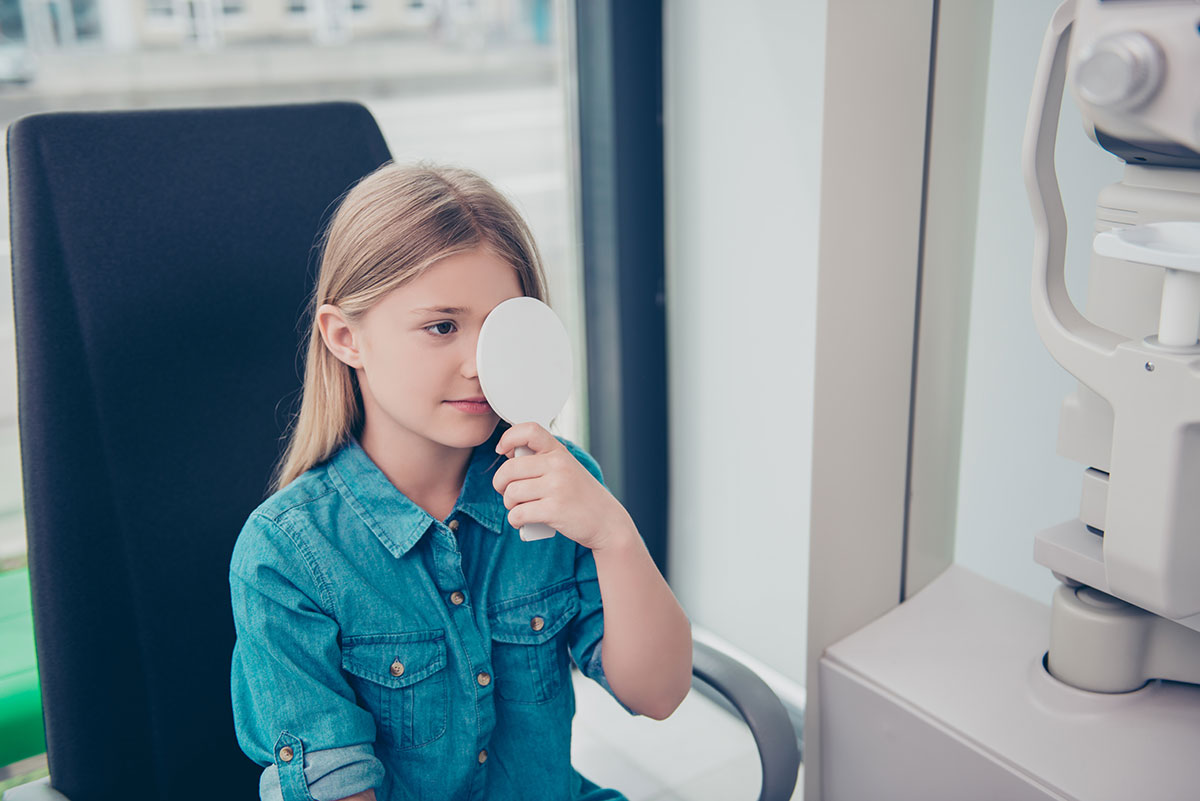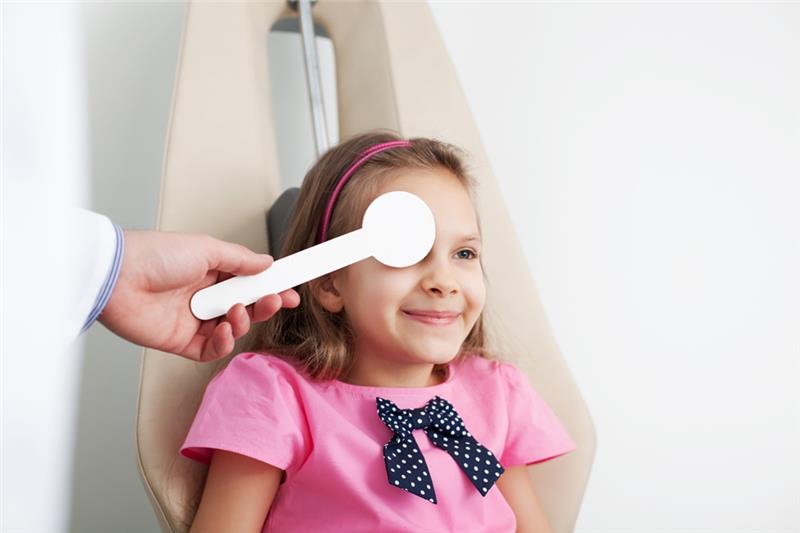Keep an Eye on Your Child’s Vision
Pediatric Eye
Exam
Call Us
Hours
Location

Schedule An Appointment
Pediatric Eye Exams in Ken Caryl, CO
At the Eyecare Center of Ken Caryl, we provide pediatric eye exams in Littleton, Colorado, for children ages 10 months and older. Working with children is rewarding because it allows us to help them gain clarity and awareness of the vast world around them. Nothing compares to the joy of guiding a child toward a new perspective.
Our optometrists are also experts in helping children with myopia, also known as nearsightedness. When a child is diagnosed with myopia, the condition usually tends to get worse as they grow. We now know that progressive myopia can increase their risk of developing serious eye conditions later in life, and we provide myopia management in Ken Caryl, Colorado to slow down or even stop myopia from worsening.
When does your child need to visit the eye doctor?
We recommend that a child receive their first eye exam before their first birthday. For school-aged children, you should schedule an eye exam every two years if no vision correction is required. Children who need eyeglasses or contact lenses should be seen annually or as recommended by the eye doctor.
We are proud to participate in the InfantSEE® program through which we provide a free pediatric eye exam for babies aged between 6–12 months.
What to expect at your child’s eye exam
A pediatric eye exam generally includes a case history, vision testing, determining whether eyeglasses are needed, testing eye alignment, an eye health evaluation, and prescribing eyeglasses if necessary. The exam process for our pediatric patients is like the comprehensive eye exam we provide for adults. However, some of the tools and tests we use are different for children.
- Often, children cannot tell you if they are experiencing difficulties or changes with their vision, so we are prepared to assess their need for eyeglasses without much response from them during the refraction test.
- We recommend dilation as part of all pediatric exams because this enables the eye doctor to get a more complete eye health picture and check an eyeglasses prescription on a stable relaxed system.
- If your child is 12 years or older, a retinal photo is also great for a baseline. For some children, the eye exam process may need to be completed over multiple trips.
After your child’s eye exam, if they need eyeglasses, our optician can help your child find a frame that fits properly. The optometrist will determine the frequency of examinations based on exam findings and patient age.
Why are eye exams important for children?
It’s important for children to have regular eye exams, as many vision problems and eye diseases can be detected and treated early. Vision is essential to learning. Eighty percent of all learning is visual, which means children with vision problems are at a huge disadvantage. Our pediatric eye exams in Littleton ensure children have the following visual skills necessary for effective reading and writing:
- Excellent vision for near, up-close work and distance.
- Comfortable and correct “eye teaming,” which means the eyes work well together and can focus on the same place in space.
- The ability to adjust focus to see clearly at different distances.
- Accurate eye movement skills, such as the ability to read a line of text.

What are the signs of vision problems in children?
Detecting vision problems in children can be challenging. Often, children are unaware that they have a vision problem and assume that everyone sees the way they do. However, there is good news: most vision problems and eye issues can be identified during a thorough pediatric eye exam administered by a qualified optometrist.
If your child displays any of the signs listed below, they may have a vision or eye health problem and should see a pediatric optometrist. However, it’s important to remember that your child may exhibit no symptoms and still have an eye issue.
Signs of vision problems in children include:
- Frequent blinking, squinting, or irregular eye movements
- Frequently turning or tilting their head
- Covering or closing one eye to see better
- Poor hand-eye coordination or motor skills
- Rubbing their eyes frequently
- Frequent headaches
- Leaning in too close to see something or read
- Learning difficulties and poor handwriting
Schedule a pediatric eye exam in Ken Caryl, Colorado
Our expert pediatric optometrists and team provide comprehensive eye health and vision care for babies and children. Children need to get regular pediatric eye exams to ensure they have the visual skills necessary for reading, writing, and living up to their full potential. Schedule an appointment for a pediatric eye exam in Littleton today!
When should my child's eyes be examined?
Children’s eyes should be examined regularly to monitor their vision development and overall eye health. Here is a recommended schedule for pediatric eye exams:
1. First Exam: The first comprehensive eye exam should occur at around 6-12 months of age. This early exam is crucial for detecting any potential eye issues or developmental concerns.
2. Subsequent Exams: After the initial exam, children should have follow-up eye exams at the ages of 3 and 5 years old. These exams help track the progress of their vision and ensure that any emerging issues are addressed promptly.
3. Annual Exams: Starting from age 6, children should have annual eye exams. Regular exams are essential during childhood as vision changes can occur rapidly, and early detection of vision problems is vital for proper development and academic performance.
4. More Frequent Exams Based on Diagnosis: Children with existing eye conditions, a family history of eye problems, or those who exhibit signs of vision difficulties may require more frequent eye exams. Your optometrist will determine the appropriate exam schedule based on your child’s specific needs and diagnosis.
Key reasons for regular pediatric eye exams include:
• Detecting Vision Problems: Early detection of refractive errors (e.g., nearsightedness, farsightedness, astigmatism) and amblyopia (lazy eye) is crucial for timely intervention and treatment.
• Monitoring Eye Health: Regular exams help monitor the health of the eyes, including checking for conditions like strabismus (eye misalignment), focusing issues, and eye diseases.
• School Readiness: Good vision is essential for academic success. Early identification and correction of vision problems can improve learning outcomes and overall school performance.
By following a consistent schedule of eye exams for your child, you can ensure optimal eye health, early intervention if needed, and support their overall well-being. Always consult with your optometrist for personalized recommendations regarding your child’s eye care needs.
Will sitting too close to the television set hurt my child's eyes?
Sitting too close to the television set is unlikely to cause permanent harm to your child’s eyes, but it may lead to temporary discomfort or eye strain. Here’s a detailed response:
While sitting close to the television set may not cause permanent damage to your child’s eyes, it can lead to temporary eye discomfort or strain. Here are some key points to consider:
1. Eye Strain: Sitting too close to the TV screen or any digital device can strain the eyes, leading to symptoms such as eye fatigue, headaches, blurred vision, and dry eyes. This discomfort is often temporary and can be relieved by taking breaks and practicing good visual habits.
2. No Long-Term Damage: Contrary to popular belief, there is no scientific evidence to suggest that sitting close to the TV causes permanent damage to the eyes or leads to conditions like nearsightedness (myopia) in children.
3. Recommended Viewing Distance: The American Academy of Ophthalmology recommends that children maintain a viewing distance of at least 18 to 24 inches from the screen to reduce eye strain. This distance allows the eyes to focus comfortably without excessive effort.
4. Healthy Viewing Habits: Encourage your child to take regular breaks from screen time, follow the 20-20-20 rule (take a 20-second break every 20 minutes and look at something 20 feet away), and ensure adequate lighting in the room to reduce eye strain.
5. Underlying Vision Issues: If your child consistently sits very close to the TV or holds books or devices too close, it may indicate an underlying vision issue such as nearsightedness or astigmatism. In such cases, a comprehensive eye exam by an optometrist is recommended to assess and address any vision problems.
In summary, while sitting close to the TV is unlikely to cause permanent harm, it’s essential to promote healthy viewing habits and monitor your child’s screen time to prevent eye strain and discomfort. If you have concerns about your child’s vision or screen habits, consult with an optometrist for guidance and recommendations.
Is my child likely to inherit my need for glasses?
The likelihood of your child inheriting your need for glasses depends on various factors, including genetics, family history, and environmental influences. Here’s a response that covers these aspects:
The likelihood of your child inheriting your need for glasses depends on several factors, including genetics, family history, and environmental influences.
1. Genetics: Vision conditions such as nearsightedness (myopia), farsightedness (hyperopia), and astigmatism can have a genetic component. If you or your partner wear glasses or have refractive errors, there’s a higher chance that your child may inherit similar vision needs.
2. Family History: A strong family history of vision problems, especially among parents or siblings, can increase the likelihood of children needing glasses. However, genetics alone do not determine vision outcomes, as other factors play a role.
3. Environmental Factors: While genetics play a significant role, environmental factors such as prolonged near work (reading, screen time), inadequate outdoor time, and improper visual habits can also influence the development of refractive errors in children.
4. Regular Eye Exams: Regardless of family history, it’s essential for children to have regular eye exams starting from a young age. Early detection of vision issues allows for timely intervention and treatment, which can help manage vision problems effectively.
5. Preventive Measures: Encouraging healthy visual habits, such as maintaining a proper viewing distance from screens, taking breaks during near work, and spending time outdoors, can help reduce the risk of vision problems in children.
It’s important to note that while genetics can play a role in determining the need for glasses, it’s not a guarantee that children will inherit specific vision conditions. Regular eye exams, a healthy lifestyle, and early intervention for any detected vision issues are key factors in promoting optimal eye health for children. Consulting with an optometrist can provide personalized recommendations based on your child’s individual circumstances and family history.
